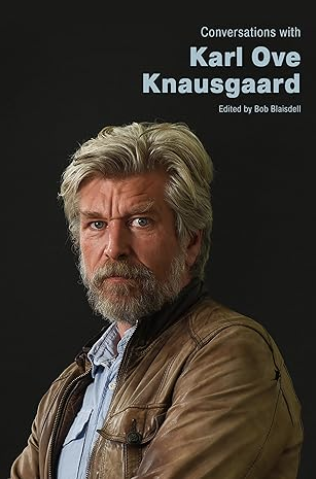(Dec 08, 2023) You may not be aware . . . But I interviewed Karl Ove Knausgaard back in 2012, before he achieved a worldwide fame with his six-volume autobiographical series My Struggle as part of my own TV series, Books du Jour. The interview has just been published by the University Press of Mississippi, along many other in-depth conversations from the literary landscape. Bob Blaisdell did a remarkable job editing all these conversations in this must-have book. Whether you are a Knausgaard fan or simply a curious aspiring author or reader here is your chance to get a close look at Knausgaard’s creative process.
Tag Archives: book review
Author du Jour: Douglas Rushkoff
 If you do not know who Douglas Rushkoff is, it is not too late to catch up. You will not regret it. He is the Naomi Klein male version. While I am not sure, he would appreciate I say this, this is, if I am right, his fifteenth plus books on culture, the digital economy and media, and he only gets better, clearer, punchier and to the point, with each new book. Rushkoff knows how to inspire and shock the crowds by revealing flaws and exposing false assumptions. His unique vision of the Techno-hyper-mediatized landscape is a perception we cannot do without. In this new book, “Team Human,” Rushkoff zeroes in on the pervasive effect of our most cherished human accomplishment: our technology, and what it is doing to you, to us, to our society . . . Here I will defer my authority to his clarity of thoughts and future projections. Get his book now.
If you do not know who Douglas Rushkoff is, it is not too late to catch up. You will not regret it. He is the Naomi Klein male version. While I am not sure, he would appreciate I say this, this is, if I am right, his fifteenth plus books on culture, the digital economy and media, and he only gets better, clearer, punchier and to the point, with each new book. Rushkoff knows how to inspire and shock the crowds by revealing flaws and exposing false assumptions. His unique vision of the Techno-hyper-mediatized landscape is a perception we cannot do without. In this new book, “Team Human,” Rushkoff zeroes in on the pervasive effect of our most cherished human accomplishment: our technology, and what it is doing to you, to us, to our society . . . Here I will defer my authority to his clarity of thoughts and future projections. Get his book now.Author du Jour: Meredith Maran
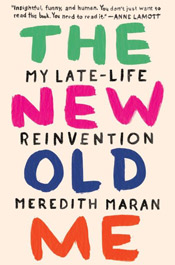 “The New Old Me” by Meredith Maran
“The New Old Me” by Meredith Maran
(Blue Rider Press, pp 302, $27.00)
A great undiscovered jewel, and from what I infer, a book that deserves to get into every single book club in the nation, and beyond. My enthusiasm is perhaps excessive. There comes a time when a book appears and has valuable lessons to teach us. We learn something we never suspected existed. People in their 60s’ have a life as well, and they go through ups and downs like the rest of us, and still have to learn lessons along the way. They can even display resilience and an appetite for life. It is pleasant surprise that a publisher would release a book that actually concerns our aging nation, where so much emphasis rests on the land of twenty-something Lena-Dunham wannabes teaching the world with great self-assurance life lessons and proper etiquette. Which begs the question: what is more interesting, someone who fumbles through life while brandishing a narcissistic flag and seems to have all the answers? Or someone who has worked hard to build a life, only to lose everything overnight and who has to pick herself up to start again—at age sixty?
This is exactly what happens to Meredith Maran who had a perfect life, meaning living with a sense of safety that no one could ask for more, with a good marriage (to the woman of her dream), a beautiful Victorian house, a good writing career, and an active social life. And then Life comes knowing at her door, like it tends to when things are going too well, and it takes everything away, and more. The best friend dies; her father is diagnosed with Alzheimer; she loses her job, and the house, along with the marriage. Welcome to “The New Old Me.” This is where we meet Meredith, dead broke about to move to La La Land, CA, where she struggles to rebuild her life and self, with all the scrawny feathers that come attached to them, fanned by heartache, loneliness, and self-doubt. The energy of the prose however shows us that beyond the circumstances lies a strong-willed and witty woman, and sure enough slowly Meredith crawls out of her trenches, and she does so with humor. For those in search of summer inspiration, this is your book. Look no further. (It was my wife’s favorite read so far this year.)
Author du Jour: Beatriz Williams
 “The Wicked City,” by Beatriz Williams
“The Wicked City,” by Beatriz Williams
(William Morrow, pp 368, $26.99)
In “Wicked City,” one can smell the whiffs of Fitzgerald’s Nick Carraway as he journeys back and forth between New York and East Egg. You can touch Princeton, the Prohibition, the allure of speakeasies with Fitzgerald pouring himself a scotch, and nudging the fabulously wealthy yawning at thought of attending the next party. From where we stand, the era feels like a distant shore, a fata morgana only made possible by the booming business and new wealth created overnight, the windfall of WWI. In typical Hollywood stories, with the new breed of winners come the losers, and not necessarily those who never had, but rather those who tried hard, got there, and walked away on a whim, which, for many of us, reveals a certain disposition towards foolishness. This is where Williams starts her two-time-framed narrative. The story moved from present to past and back and forth. “Wicked City” is a Nick Carraway journey in reverse.
Ella Gilbert starts at the top of society and decides to leave it all behind upon learning that her banker husband cheats on her. She trades her life of luxury and high-comfort in Soho for a small pad of Greenwich Village. That’s for the near present. But Williams’s story also is situated in 1924, where the Village was not the ultra-expensive resort for the startup moguls of today. Back then there were forbidden places, where more prosaic people went in search of excitement. The place in question is a speakeasy, the Christopher Club. The club introduces the second protagonist, Geneva Keely, a flapper, who gets caught in a raid and is forced to help the police track down her father, an important bootlegger . . . The story takes its own flight as we ponder how the two narratives are interrelated, making the twists and turns highly entertaining and surprising.
Author du Jour: Elizabeth Blackburn & Elissa Epel
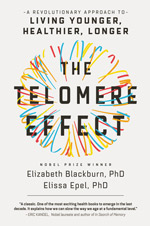 “The Telomere Effect: a Revolutionary Approach to Living Younger, Healthier, Longer,” by Elizabeth Blackburn, PhD and Elissa Epel, PhD
“The Telomere Effect: a Revolutionary Approach to Living Younger, Healthier, Longer,” by Elizabeth Blackburn, PhD and Elissa Epel, PhD
(Grand Central Publishing, pp 399, $28.00)
Whoever came up with the subtitle for this fascinating book did an excellent job creating a strong hook. Who indeed would not want to live longer? Contrary to what you may consider, that life is just a game of roulette, with molecules moving one way and DNA reacting in another, the authors claim that you can certainly influence your longevity. To entice you into their secret, they ask: why some people at 40 look like 60, while others at 60 look like 40? The story narrated here deals with telomerase and, more precisely telomeres, which are the capstones at the end of the DNA, whose states mirror the way we treat ourselves. Good telomeres will keep you disease free longer. Translation: your lifespan will be elongated.
Here, as in diet books, we find that the main culprits for premature aging: quality of sleep, frequency of exercise, types of diet, and chronic stress, all of which deeply impact our telomeres. Over the book, Dr. Elizabeth Blackburn (Nobel Prize winner) and Dr. Elissa Epel clearly demonstrate the mind-body connection. Having recurring negative thoughts for example will affect also your telomeres, and your appearance. Telomeres shorten in repeated adverse conditions. People looking healthy have long telomeres. So the main question you should ask yourself, and it should make you want to pick up this book at once, is whether a body who has been exposed to all types of unhealthy habits and physical and self-inflicted mental abuses can reverse damages done to the capstones of its DNA? In other words, are frayed telomeres irreversible? The book goes at great length to provide answers. Particularly fascinating are the chapters discussing the impact of early trauma during pregnancy and income inequalities to show the relations between depression and schizophrenia . . . which logically would mean that we may pay the price for circumstances that we do not control and that, in turn, impact our appearance. But nothing is set in black and white, and life choices still play their part. One thing is certain, reading this book will not age you.
Author du Jour: Suzanne O’Sullivan
 “Is It all in Your Head? Trues Stories of imaginary Illness,” by Suzanne O’Sullivan, MD
“Is It all in Your Head? Trues Stories of imaginary Illness,” by Suzanne O’Sullivan, MD
(Other Press, pp 296, $26.95)
Psychosomatic illness is problematic. Disregarded as not real, it is often not considered seriously and is relegated to footnotes in medical books. And yet, it is all around us, often having debilitating effects on the sufferer, which can last for years in some cases. According to Dr. O’Sullivan, it costs the health system twice as much to treat as diabetes. Expensive for imaginary treatment. Who has not heard of someone suffering from chronic fatigue syndrome or sudden memory loss? In this important book, O’Sullivan lays out her case for a new approach and treatment methods for psychosomatic illness. Her argument is convincing. Taken from real life experiences, through her work as a neurologist and neurophysiologist, she shares the cases of some of her patients and ponders how come so many of them complain about symptoms without any physical manifestation? Is it really all in their head?
At first brush the book can appear predictable, since each chapter is matched with a specific patient. There’s Pauline, Camilla, and Rachel among others. But each has been carefully selected to illustrate precisely O’Sullivan’s claims. The plurality of psychosomatic manifestations run far and wide and would appear to stem from hidden stress and major traumas. O’Sullivan points out surviving rape or exposure to chronic mental abuses as being frequent culprits. We’ve known for century that the mind can affect our physical health. But clearly, here O’Sullivan seeks to establish a connection between mind and body that goes beyond simple mood disorder treatment. She advocates for new ways to look, understand and treat unexplainable symptoms, paving the way for bringing relief to her patients. Some of the cases will break your heart. Matthew did it for me.
Author du Jour: A. Scott Berg
 “World War I and America: Told by the American Who Lived It,” edited by A. Scott Berg
“World War I and America: Told by the American Who Lived It,” edited by A. Scott Berg
(Library of America, pp 896, $40.00)
Besides the inviting silky quality of the paper, this volume from the Library of America offers an impressive collection of articles, essays, personal stories, and declassified documents from WWI, from both participants and observers. The volume aims at providing a never-before kaleidoscope view of the “never again” war, that is the French-German butchery which supposedly was going to be the war that ends all wars.
I can only imagine the headaches A. Scott Berg, the supreme editor of the book, must have experienced to decide what to include and exclude. The wealth of the materials is just staggering, spanning the beginning of the war to the ratification of the infamous “Versailles Treaty.” Lots of names will be recognizable to the modern readers, Edith Wharton, John Reed (who proceeded to go to Russia), Willa Cather, W.E.B Dubois, and of course Woodrow Wilson. But there are many others to whom history has not been so kind and who nonetheless made important contributions. Charles Lauriat is one of them. His telling of the sinking of the “Lusitania” reads like a novel, a first direct personal account of the tragedy during the swift German Torpedo attack. The sinking of the luxury liner was pivotal, for it signaled an important escalation towards the eventual US entry into the WWI conflict in 1917. The major lessons to be learned here come from the abundance of testimonies left to us as vestiges of the past, from which we are still trying to make sense. Given that in our new millennial age the past seems to carry less and less weight, the publication of this volume offers an in-depth ballast to anchor ourselves with the understanding that where we stand today is not so random. Especially in the light of the upcoming 100-year anniversary. Time for reflection is never wasted.
Author du Jour: Alan Jacobson
March 2017. Only six weeks have elapsed since Trump took power, and what a contrast with the previous administration. The country seems to have been seized by the invisible hand of hysteria and neurosis. In recent memory, never a concentration of angry and vocal citizens has been so strident and quick to gather. In this time of uncertainty, it is always wise to take a deep breath and step to the sideline to better understand what is happening. Are we deluding ourselves with this new administration? Is the threat real? Or are we just venting the seething resentment that has been cementing since the beginning of the Great Recession and, why not, the costly Iraq War? This month’s selection provides reflections on our national and chaotic mental states.
 “The Darkness of Evil,” by Alan Jacobson
“The Darkness of Evil,” by Alan Jacobson
(Open Road Integrated Media, pp 488, $16.99)
Sanity can be regained in many ways. While there are those who go to great lengths to analyze a person’s psyche to better penetrate it and spend a great deal of time to suggest curative solutions by trial and error, there are also those who advocate the more expeditive fire-by-fire approach. Divergent psychologies imply different perception and understanding of humankind. This is where Alan Jacobson (a truly underrated author) situates himself. Not that he necessarily believes in the latter approach, but in terms of thriller writing, his willingness to throw his characters into the darkest recesses of the human mind makes his story feel like boarding a hell-train from page one. His new Karen Vail’s novel, “The Darkness of Evil” is beautifully layered for this reason.
Think for a second if you woke one morning and found out your father was a serial killer. What would you do? What would you say? This is what happens to Jasmine Marcks, one of the protagonists. Is it possible to love a father who tortures innocent young women? Can a sadistic killer be a good father? Whose allegiance should a daughter have in mind, the community or her father? No easy answer, no matter who we are. But here the novel addresses the question in an original way. Jasmine, who turned her father in to the police, has written a book about him. But the incarcerated serial-killer father manages to escape and now seeks revenge. Karen Vail must protect Jasmine from her own father. But what is Jasmine now going to do about it? . . . “The Darkness of Evil” is a brisk, surprise-filled twisted ride, which will drain every ounce of darkness out of you and make you feel like a sober angel.
Author du Jour: Dalai Lama, Desmond Tutu, Douglas Abrams
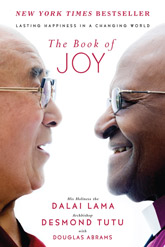 “The Book of Joy,” by the Dalai Lama, Desmond Tutu, and Douglas Abrams
“The Book of Joy,” by the Dalai Lama, Desmond Tutu, and Douglas Abrams
(Avery, pp 356, $26.00)
A major contradiction lies at the heart of Western societies. The constant pressure towards the quest for happiness. It is no secret that the pressure to be happy creates more anxiety than happiness. Tons of books from fields as varied as sociology, psychology or self-help, have attempted to deal with this issue. Often providing short-time relief with Band-aid remedies, which, as their names indicate, never last over time. Even before pre-Socratic thinkers it was known that happiness never comes from achievement or success, or wealth, or even fame for that matter. And yet, our Western societies keep on promoting these values, with disastrous results on its members. Depression, neurosis, feeling of inadequacies, feeding an endless loop of existential FOMO, and so on, abound around us.
“The Book of Joy,” is one of those timeless books that aims at cutting straight through the glut of daily self-pressured drives and bad self-talk. Written by the Desmond Tutu and the Dalai Lama, with Doug Abrams, “The Book of Joy,” details their conversations, which took place over a one-week period in Dharamsala, India. The goal of the book, beyond reuniting the two spiritual leaders, was to teach the world that the quest for happiness is precisely a futile endeavor, because it is ephemeral. They profess instead to rely on joy, at any moment in life. Especially in time of tragedy and great suffering. Both of them are living proofs, having witnessed countless atrocities. “Every tragic situation can become an opportunity.” Abrams who has a strong Eastern interest translates the teaching into accessible lessons. The message is clear and easily absorbed. But like all disciplines, mastery requires a daily practice. No way around it.
Author du Jour: Eric Beaumard
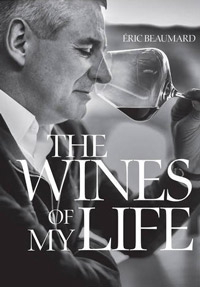 “The Wines of My Life, ” by Eric Beaumard
“The Wines of My Life, ” by Eric Beaumard
(Abrams pp 280, $45.00)
“The Wines of My Life” is a very important book for two reasons. First it was written by, perhaps, the most influential sommelier in the world, Eric Beaumard, who from humble origins and a major road accident that left him physically impaired (he lost an arm), but which only fortified his spirit, hoisted himself to the top rank of the wine tasting industry. For years, Beaumard was head sommelier of “Le Cinq” the prestigious restaurant located inside the Four Seasons George the Fifth in Paris. The second reason is more prosaic. BJD contributed to the translation of the book in the US.
Eric Beaumard narrates his tribulations around the world where he visits established names in red, white and champagne wines, Chateau Petrus, Dom Pérignon, Rothschild, to name a few, as well as discovers new upcoming crus and grapes. The present book portrays 75 exceptional wines. Beaumard goes to great lengths to describe why these wines standout from the rests. He traces their origins, history, and evolution through time, meaning winemaking process, traditional or scientific. His meditations are a nose-filled journey through the memoirs of deep musty echoing cellars, the wafting scents of fermentation-stained barrels, and the climbs of steep arid and muddy hills. Whether you are a wine aficionado or not, “The Wines of My Life” will seduce your palate so much that you will not be able to reject the indelible notes this man is offering you.
